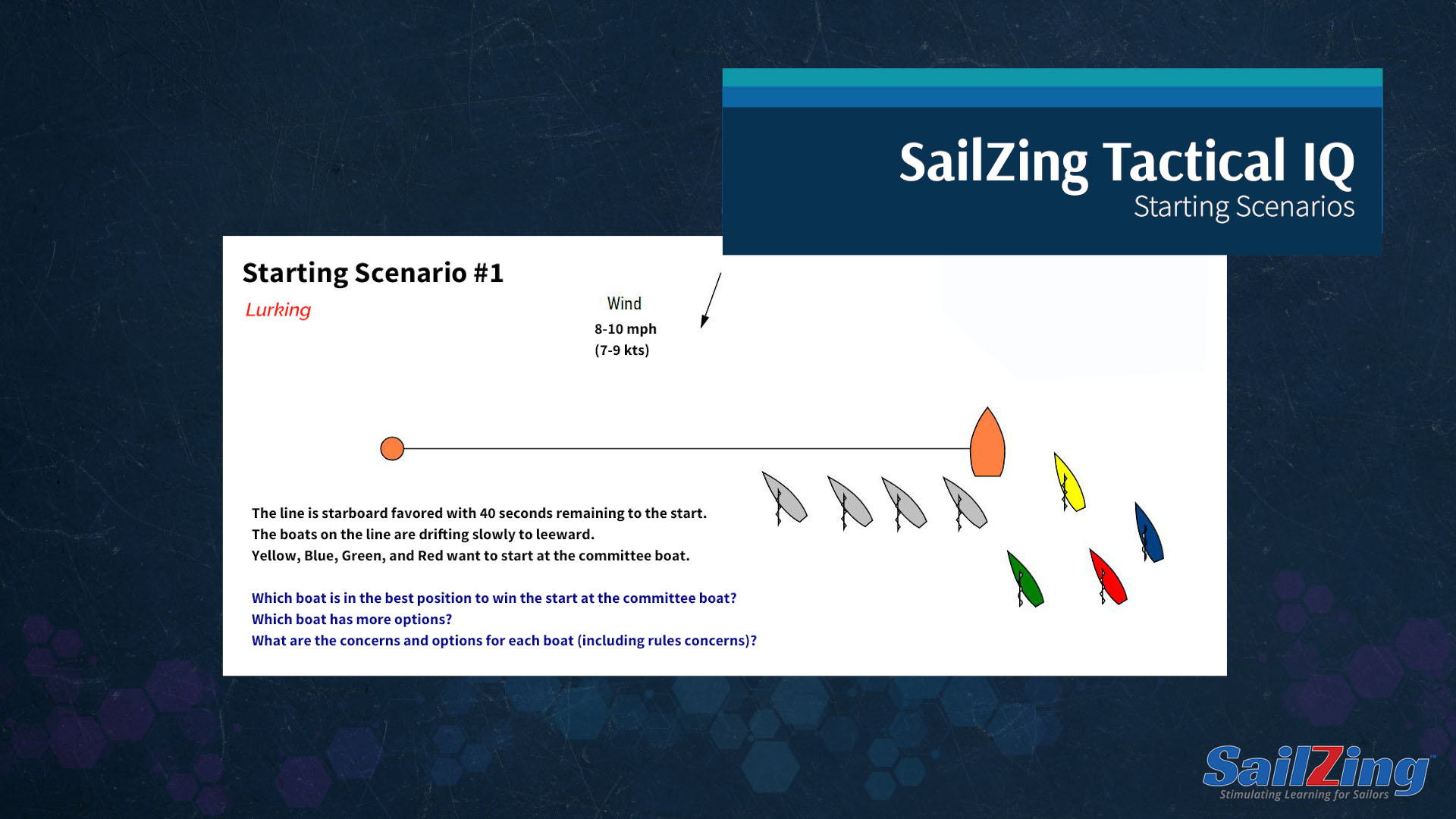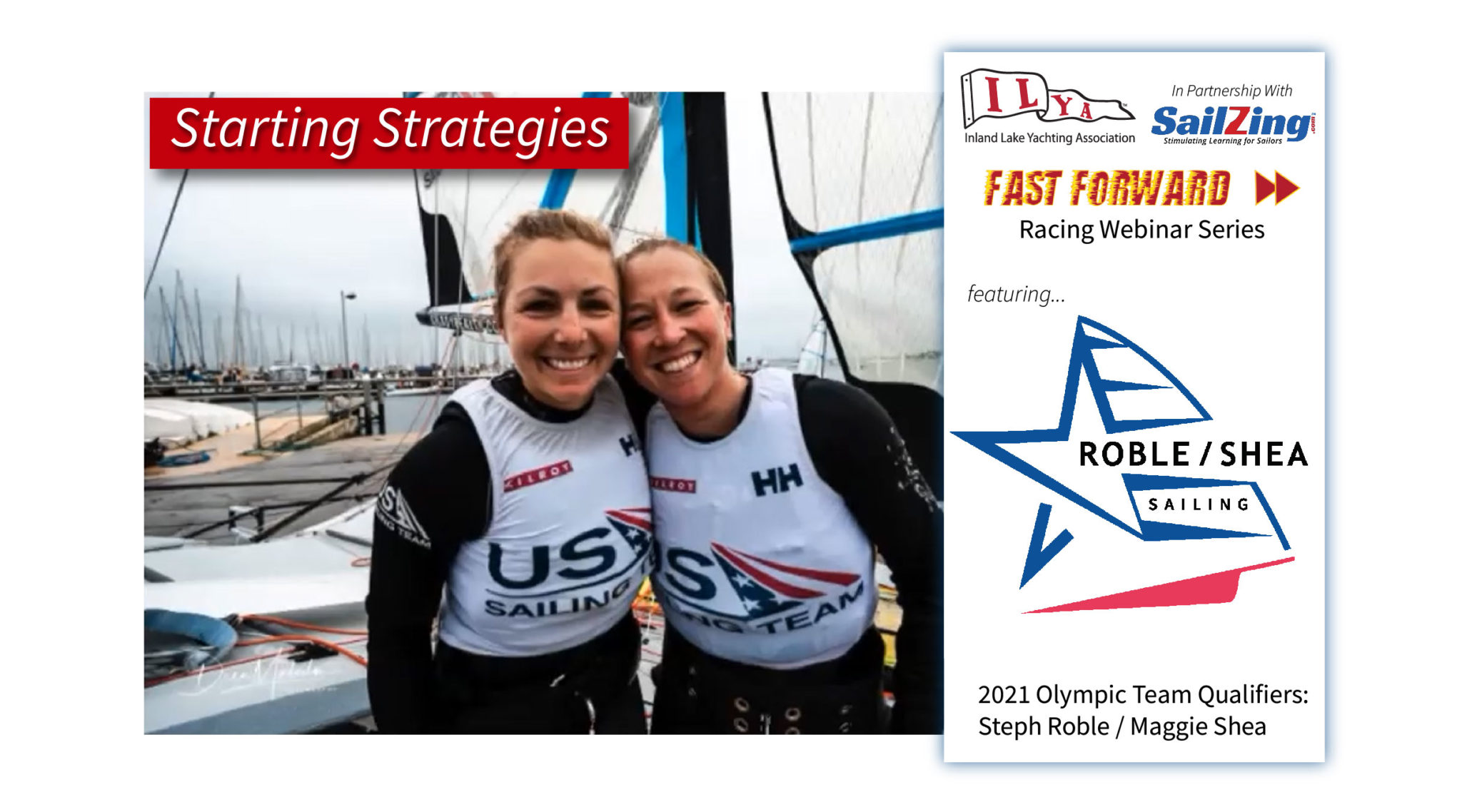SailZing is presenting a series of “Tactical IQ” sessions to help you think through common race situations. For this session, we put six starting tactics scenarios in front of a group of scow sailors with SailZing’s model boats and recorded the discussion to see what we could learn.
Read each scenario description and decide what you would do. Then watch the video discussion (Video is below) or read the summary of key points. Give us some feedback by commenting below.
Full video:
Scenario 1 – Lurking
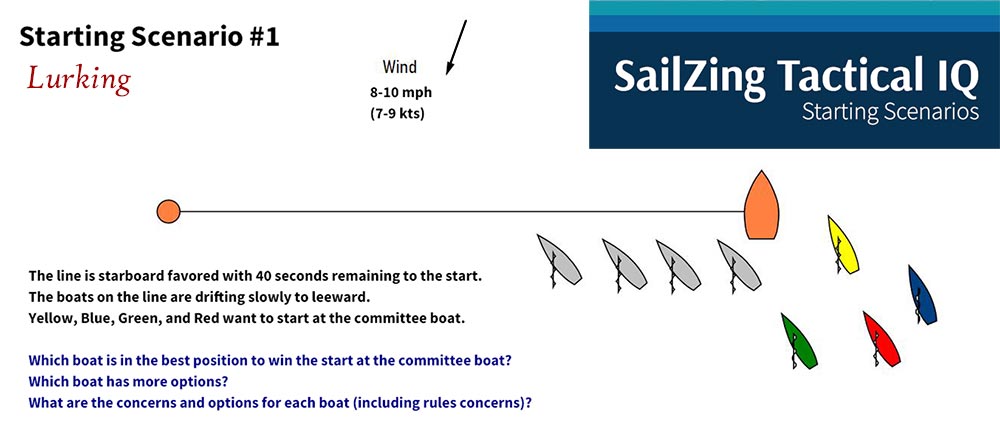
Key points from the discussion
Options for winning the committee boat end
Each boat has a reasonable option to win the start at the committee boat. The boat that fills the developing gap first will have the best chance.
- With the wind from the right, Yellow can raise her boards and slide into the developing gap. She needs to get the bow to pivot around the rudder without moving forward. She can do this by artfully centering the rudder to prevent the stern from slipping and then deflecting it as needed to act as a brake. This may require pushing the tiller to leeward to prevent the boat from turning too far down. She has to act quickly, because others will have an easier time of filling the gap.
- Blue and Red can both head down without gaining too much speed and close Yellow out of the gap. Red is in a better position to do this than Blue. Blue can only be successful if Red stays put.
- Green can shoot up hard on the wind to get close to the first grey boat’s transom and be ready to fill the gap as grey drifts.
If you get shut out
If any of these boats react too slowly and get shut out of the gap, they each have options.
- If Yellow and/or Blue get shut out, they can be “first followers” to the boat that wins the start at the committee boat. They can quickly tack to port after clearing the committee boat and get clear air before tacking back to starboard. Yellow will still have to minimize forward motion to avoid the committee boat. If she can’t, she will have to tack away and gybe around.
- If Green gets shut out by Yellow, Blue, or Red, she can look for another hole down the line. There is probably still adequate time to overlap another boat to leeward and force them up slightly to carve out a hole. Green can sail down the line as far as needed to find a clear lane.
- Red will be in a tough spot if she gets shut out and Green does not sail down the line. Red may have to find a way to bear off behind Green and sail down the line. Or, she may have to accept a second row start and tack to port for clear air.
Rules concerns
Key rules involved in this situation are highlighted below. Click on the link to read the full rule and commentary.
- Rule 11: On the same tack, overlapped. Green is in the most favorable position of the colored boats to take advantage of this rule.
- Rule 12:On the same tack, not overlapped. The first boat to close the gap without being overlapped gains the advantage.
- Rule 15: Acquiring right of way. This limits a leeward boat’s actions when initially acquiring an overlap. Look at Scenarios 2 and 3 in this series for common situations involving this rule.
- Section C preamble: A windward boat cannot take advantage of the rules for mark room or obstructions while boats are approaching a starting mark surrounded by navigable water.
Scenario 2 – Shutting the Door
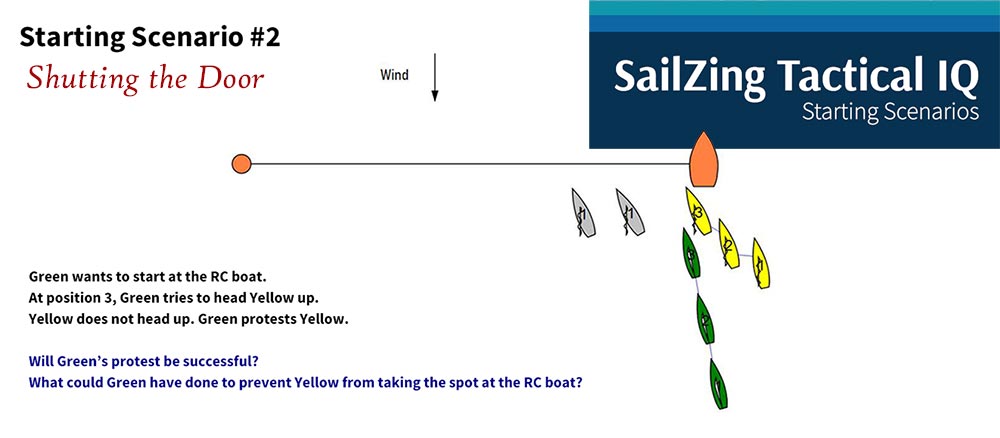
Click image above or start at 06:37 in video at top of post.
Key points from the discussion
Green’s protest will not be successful. If Green achieves an overlap with Yellow at position 3, Green cannot head Yellow up into the committee boat. Rule 15 requires Green to give Yellow room to keep clear when initially acquiring the overlap. At position 3, Yellow cannot head up to avoid Green. To shut Yellow out, Green must acquire the overlap before Yellow is pinned by the committee boat transom.
Scenario 3 – Stealing a Hole
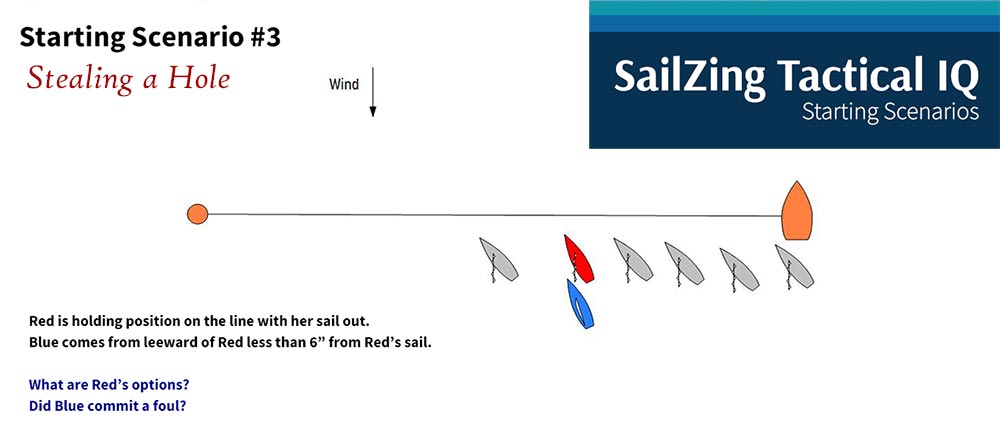
Click image above or start at 09:07 in video at top of post.
Key points from the discussion
Blue did not commit a foul in the situation described. Rule15 requires Blue to allow Red room to initially keep clear. When Blue establishes the overlap, Red has room to keep clear by pulling in her sail. Red does not need to anticipate Blue’s overlap, but once established, Red must respond. If Red waits until she can no longer respond, Red has violated Rule 11.
Two examples of things Blue can’t do:
- Blue can’t overlap the corner of Red’s transom so close that Red can’t turn up without contacting Blue.
- Blue can’t sail so quickly behind Red’s sail that Red does not have time to pull it in without hooking Blue’s forestay.
To defend, Red needs to be aware of the boats behind to either side. As soon as she sees someone threatening her gap, she should bear off and let out her sail to make the gap less appealing. Make eye contact and be deliberate and you will likely scare off the opponent. Once you repel the opponent, you can head up again to re-establish the gap.
Scenario 4 – Port Approach
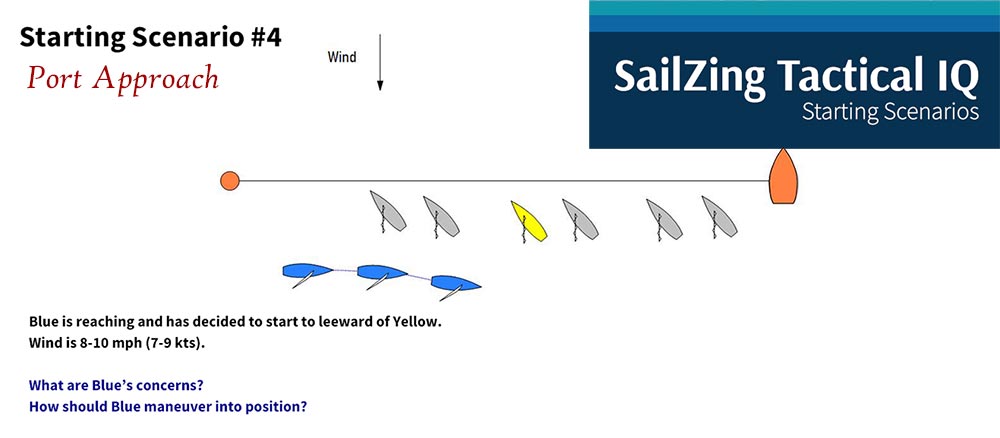
Click image above or start at 12:11 in video at top of post.
Key points from the discussion
This is a fairly large gap. Blue can take the “friendly” approach and tack into the middle of the gap, leaving room for everyone to get a clean start.
If Blue wants to push it, she should sail slightly past Yellow to avoid signaling her intentions too early and to establish herself on starboard tack before overlapping Yellow.
Rule 13 (while tacking) prevents Blue from heading Yellow up without completing her tack to starboard. To complete her tack, Blue must head down to a close-hauled course.
Scenario 5 – Kinetics
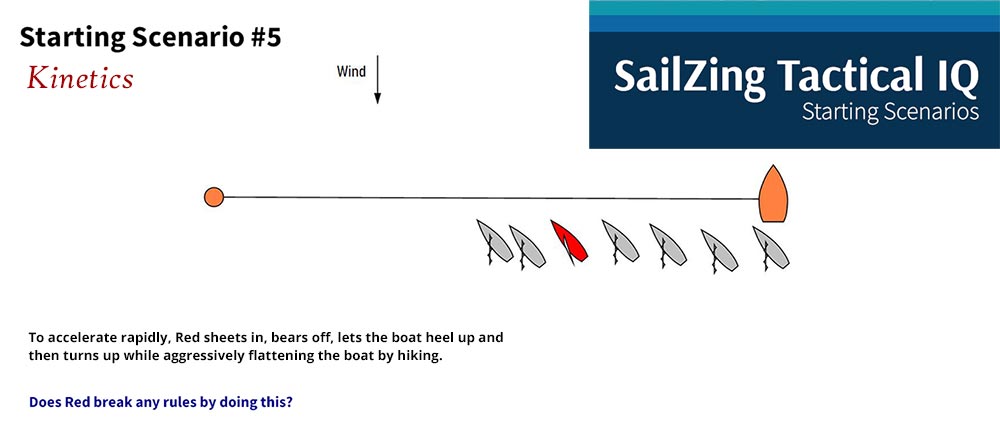
Click image above or start at 17:17 in video at top of post.
Key points from the discussion
Rule 42.3 allows Red to roll the boat to facilitate steering. If Red lets the boat heel to facilitate steering up, and then flattens the boat to facilitate bearing off, she has complied with Rule 42. If she does it without turning, or does it repeatedly, she has violated Rule 42.1 and 42.2(a).
This is a good technique for accelerating and also for maintaining your position on the line. See Shirley Robertson’s video on accelerating a Laser and our post on Shooting Up to Maintain Your Gap
Scenario 6 – Crowded Port Approach
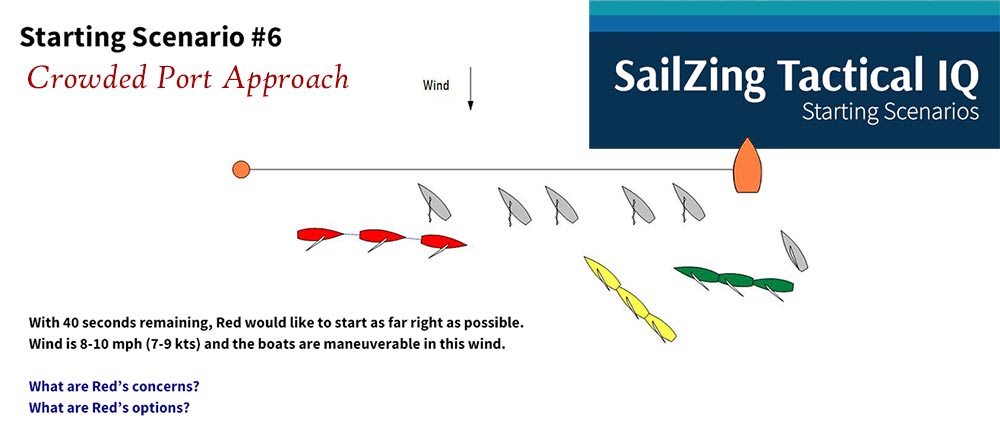
Click image above or start at 19:56 in video at top of post.
Key points from the discussion
Red probably only has about a 50% chance of a clear start at the right end of the line, so it’s important to decide whether it’s worth the risk to start there. It might be safer for Red to take one of the holes nearby to have a better chance at clear air. If it is worth the risk, due to more wind or a favorable shift, Red will have to duck Green and Yellow and then find a hole to tack into.

